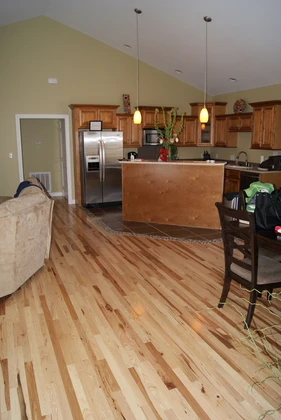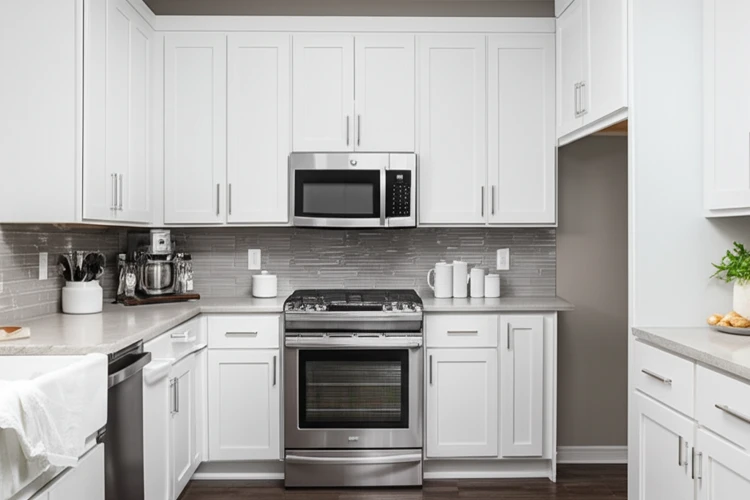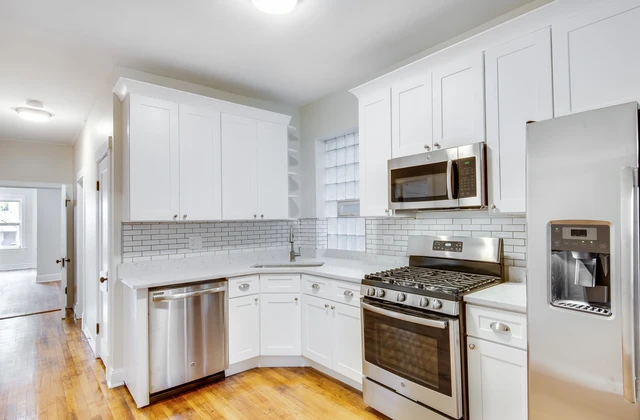Disclaimer: As an Amazon Associate, I earn commission from qualifying purchases.
As the trend of open floor plans continues to dominate home design, the combination of living rooms and kitchens has become increasingly popular. This design not only enhances the flow of the home but also creates a more sociable and functional space. However, choosing the right paint colors for this combined area is crucial to achieve a harmonious environment. With over a decade of experience in interior design and home improvement, it’s clear that the right color scheme can transform a space, making it feel more inviting, spacious, and cohesive.
The Psychology of Color in Home Design
Color psychology plays a significant role in home design, impacting both mood and productivity. For a combined living room and kitchen space, the choice of colors can influence how you feel and interact within the area. Warm colors like yellow and orange can evoke feelings of warmth and comfort, making them ideal for social spaces. Cool colors like blue and green are known for their calming effects, perfect for creating a serene atmosphere. Neutral tones such as beige and gray offer a sense of balance and sophistication, suitable for those who prefer a more subdued environment.
According to a study by the University of Texas, colors can significantly affect productivity and creativity. For example, red can increase heart rate and blood flow, which might be too stimulating for a relaxed living area but could work well in a kitchen where energy is needed. In contrast, green promotes harmony and efficiency, making it a versatile choice for combined spaces.
Key Considerations for Choosing Paint Colors
Selecting the right paint colors for your combined living room and kitchen involves considering several factors:
- Natural Light: The amount of natural light in your space can dramatically affect how colors appear. Bright, natural light can enhance lighter colors, while dimmer lighting might require warmer tones to avoid a dull appearance.
- Room Size: Lighter colors can make a small room feel more spacious, while darker shades can add depth and coziness to larger areas.
- Furnishings: Consider the colors of your existing furniture and decor. Neutral walls can complement a variety of furnishing styles, while bolder colors might require a more coordinated approach.
Interior design principles suggest that using a consistent color palette can create a cohesive look. For example, choosing a primary color for the walls and complementary shades for accents and furniture can tie the space together seamlessly.
Popular Paint Colors for Combined Spaces
When it comes to popular paint colors for living room kitchen combinations, there are several trends to consider. Neutral tones remain a timeless choice, offering versatility and elegance. Warm tones like yellow and orange can create a cozy and inviting atmosphere, while cool tones such as blue and green provide a calming, soothing effect.
According to industry reports, neutral shades like beige and gray continue to dominate due to their ability to blend with various decor styles. However, there’s a growing trend towards incorporating warm and cool tones to add depth and character to the space.
Neutral Tones: Timeless Elegance
Neutral tones such as beige, gray, and off-white are classic choices for combined living room and kitchen spaces. These colors offer a clean, sophisticated look that can adapt to different design styles. For instance, a soft beige can create a warm and welcoming atmosphere, while a cool gray can add a modern, sleek touch.
Case studies from professional interior designers show that neutral tones can serve as a versatile backdrop for various decor elements. A neutral palette allows for easy updates and changes, making it a practical choice for those who like to refresh their decor frequently.
Warm Tones: Cozy and Inviting
Warm tones like yellow, orange, and red can infuse a combined living room and kitchen with a sense of warmth and coziness. These colors are particularly effective in creating a welcoming atmosphere, perfect for social gatherings and family time. For example, a soft yellow can brighten up a space, while a deep orange can add a touch of sophistication and energy.
Expert recommendations from color consultants suggest that warm tones can be especially beneficial in spaces that receive less natural light, as they can help to brighten and enliven the area. However, it’s essential to balance these colors with neutral accents to avoid overwhelming the senses.
Cool Tones: Calm and Soothing
Cool tones such as blue, green, and purple can introduce a calming and soothing effect to a combined living room and kitchen. These colors are ideal for creating a serene and tranquil environment, perfect for relaxation and unwinding. For instance, a soft blue can evoke feelings of tranquility, while a deep green can bring a sense of harmony and balance.
Academic studies on the impact of cool colors on mood suggest that these shades can reduce stress and anxiety, making them a suitable choice for those who seek a peaceful home environment. However, it’s important to balance cool tones with warmer accents to prevent the space from feeling too cold or sterile.
Paint Color Combinations for Small Spaces
Selecting the right paint colors for small combined spaces can make a significant difference in how spacious and open the area feels. Here are some steps to guide you:
- Choose Light Colors: Light and neutral colors can reflect light and make a small space feel larger. Opt for shades like white, beige, or light gray.
- Use a Monochromatic Palette: Sticking to a single color family can create a seamless look that enhances the flow of the space.
- Add Accents: Incorporate pops of color through accents like cushions, rugs, or artwork to add visual interest without overwhelming the space.
Professional space planners recommend using light colors on the walls and ceiling to create an illusion of a larger space. Additionally, strategic placement of mirrors and reflective surfaces can further enhance the openness of the area.
Paint Color Combinations for Large Spaces
Choosing paint colors for large combined spaces involves creating a cohesive look that enhances flow and functionality. Here are some guidelines:
- Use Darker Tones Strategically: Darker colors can add depth and drama to large spaces. Consider using them on accent walls or in specific areas to create focal points.
- Incorporate Texture: Textured paint or wallpaper can add visual interest and break up large expanses of wall.
- Create Zones: Use different shades or complementary colors to define separate areas within the combined space, such as a dining area or a reading nook.
Professional interior designers often use tools like color wheels and swatch books to experiment with different combinations and see how they interact. This approach ensures that the chosen colors complement each other and create a harmonious environment.
Accent Walls: Adding a Pop of Color
Accent walls are a popular way to add a pop of color and create a focal point in a combined living room and kitchen space. An accent wall can be a single wall painted in a bold or contrasting color, or it can feature a unique pattern or texture. For example, a deep blue accent wall can add a dramatic touch to a neutral space, while a textured wallpaper can introduce a tactile element that enhances the room’s character.
Before-and-after photos from real projects demonstrate how an accent wall can transform a space, making it feel more dynamic and visually appealing. When choosing a color for an accent wall, consider how it will complement the existing decor and the overall color scheme of the room.
Paint Finishes: The Important Role They Play
The finish of your paint can significantly impact the look and feel of your combined living room and kitchen space. Different finishes have varying levels of sheen, which affects how light reflects off the surface. Here’s a comparison of popular paint finishes:
- Matte: A flat finish with no sheen, ideal for hiding imperfections and creating a smooth, velvety look. Suitable for low-traffic areas.
- Satin: A mid-sheen finish that offers a subtle glow, easy to clean, and durable. Perfect for high-traffic areas like kitchens.
- Gloss: A high-sheen finish that reflects light and adds a polished look. Best for surfaces that need frequent cleaning, like cabinets and trim.
Industry standards and guidelines recommend using satin or semi-gloss finishes for kitchen walls, as they are more durable and easier to clean. Matte finishes are better suited for living room walls, where durability is less of a concern.
Product Recommendations
Choosing the right paint products is essential for achieving a long-lasting and high-quality finish. Here are some recommendations:
- Benjamin Moore Aura: Known for its rich color and excellent coverage, ideal for both walls and trim.
- Sherwin-Williams Emerald: Offers superior durability and stain resistance, perfect for high-traffic areas.
- Behr Marquee: Provides one-coat coverage and a smooth finish, suitable for a variety of surfaces.
Transparent pricing information and links to official product documentation can be found on the respective manufacturers’ websites. It’s essential to consider factors like coverage, durability, and ease of application when choosing a paint product.
DIY vs. Professional Painting
Deciding whether to paint your combined living room and kitchen space yourself or hire a professional depends on several factors. Here’s a comparison of the pros and cons:
DIY Painting
- Pros:
- Cost-effective: Saves on labor costs.
- Flexibility: Work at your own pace.
- Personal Touch: Add your unique style.
- Cons:
- Time-Consuming: Requires significant effort and time.
- Skill Level: May result in uneven finish if not experienced.
- Cleanup: Can be messy and require additional cleanup.
Professional Painting
- Pros:
- Quality Finish: Professional results with even coverage.
- Efficiency: Completed quickly with minimal disruption.
- Expertise: Knowledge of the best techniques and products.
- Cons:
- Cost: More expensive due to labor costs.
- Scheduling: May need to work around the painter’s availability.
- Dependence: Relying on someone else for the outcome.
A balanced perspective includes considering both cost and skill requirements. DIY painting can be a rewarding experience if you have the time and basic skills. However, hiring a professional ensures a high-quality finish and can save you time and effort in the long run.
Maintenance and Upkeep
Maintaining the freshness and longevity of your paint in a combined living room and kitchen space involves regular upkeep. Here are some tips:
- Cleaning: Use mild soap and water to clean walls regularly. Avoid harsh chemicals that can damage the paint.
- Touch-Ups: Keep extra paint for touch-ups to address scuffs and scratches promptly.
- Ventilation: Ensure proper ventilation to prevent moisture buildup, which can lead to mold and mildew.
Official cleaning and maintenance guidelines from paint manufacturers can provide specific instructions tailored to the type of paint and finish used. Regular maintenance can help extend the life of your paint and keep your space looking fresh and inviting.
Frequently Asked Questions (FAQs)
What are the best paint colors for a small living room kitchen combination?
For small combined spaces, light and neutral colors like white, beige, or light gray are ideal. These colors reflect light and create an illusion of a larger space. Additionally, using a monochromatic palette can enhance the flow and make the area feel more open.
How do I choose a paint finish for my kitchen walls?
For kitchen walls, satin or semi-gloss finishes are recommended. These finishes offer durability and are easier to clean, making them suitable for high-traffic areas. Matte finishes are better for living room walls where durability is less of a concern.
Can I use the same paint color for both my living room and kitchen?
Yes, using the same paint color for both areas can create a cohesive look. Neutral tones like beige, gray, or off-white are versatile and can work well in both spaces. However, you can also introduce accent colors or different shades to define separate areas within the combined space.
What are some tips for painting a combined living room and kitchen space?
When painting a combined living room and kitchen space, consider the overall flow and functionality. Use light colors to create a sense of openness and add accents to define different areas. Ensure proper ventilation during painting and allow ample drying time to achieve a smooth finish.
How often should I repaint my living room kitchen combination?
The frequency of repainting depends on factors like wear and tear, changes in decor, and personal preference. Generally, high-traffic areas like kitchens may need repainting every 3-5 years, while living rooms can last longer. Regular cleaning and touch-ups can help extend the life of your paint.
Are there any paint colors that can make a small space feel larger?
Yes, light and neutral colors can make a small space feel larger by reflecting light and creating an illusion of openness. Opt for shades like white, beige, or light gray, and consider using a monochromatic palette to enhance the flow of the space.
Conclusion
Choosing the right paint colors for your combined living room and kitchen space is essential for creating a harmonious and functional environment. By understanding the psychology of color, considering key factors like natural light and room size, and exploring popular paint color combinations, you can transform your space into a cohesive and inviting area.
Whether you opt for neutral tones, warm hues, or cool shades, the right color scheme can significantly enhance the overall aesthetic and functionality of your home. Regular maintenance and upkeep, along with professional insights, can ensure that your paint colors continue to elevate your living space for years to come.







